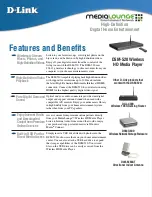
Large-scale Decoder & Sound Decoder MX695, MX696, MX697, MX699 Page 19
5.3
Decoder-ID, Load-Code, Decoder-Type and SW-Version
CV
Designation
Range
Default Description
#250,
#251,
#252,
#253
Decoder-ID
also contains
Decoder type in
CV #250
(see chapter 1,
“Product Overview” for
decoder type code)
read only
-
The decoder ID (serial number) is automatically en-
tered during production: the first byte (CV #250) de-
notes the decoder type; the three other bytes contain
the serial number.
The decoder ID is primarily used for automatic ad-
dress assignment when an engine is placed on the
layout track (future function) as well is in conjunction
with the “load code” for “coded” sound projects (see
CV #260
– 263)
#260,
#261,
#262,
#263
Load-code
for
"
coded” sound projects
-
-
New ZIMO sound decoders can be ordered for a
small fee with the “load code” pre-installed, which en-
titles the user to install “coded” sound projects of a
se
lected sound “bundle”.
The load code can also be bought and installed at a
later date: see
or ZIRC.
#8
Manufacturer ID
and
HARD RESET
with CV #8 =
“8“
or CV #8 = 0
or
ACTIVATION
of special CV sets
Read only
Reading out
the decoder
always shows
“145”, which
is ZIMO’s
assigned
number.
For pseudo
programming
see the
description
on the right.
145
( = ZIMO)
Reading out this CV always result in “145”
(”10010001”), the number issued for ZIMO by the
NMRA.
This CV is also used to execute various resets with
the help of Pseudo-Programming.
Pseudo-Programming means that the entered value is not real-
ly stored, but rather used to start a defined action.
CV #8 = “8”
HARD RESET
(NMRA standard); all
CV’s reset to the last active
CV set
(incl. sound pro-
ject), or the default values as listed in this CV table if
no such set was active before.
CV #8 = “9”
HARD RESET to old LGB-MZS
system (14 speed steps, pulse chain commands).
Further options: see chapter “CV Sets”!
#7
SW version number
Also see CV #65 for
sub-version number
and
special programming
procedures with
“Lokmaus-2” and other
“low level” systems
Read only
For pseudo
programming
see the
description
on the right
-
This CV holds the main number of the currently load-
ed decoder software (firmware).
It is also used via
“pseudo programming“ to program
decoders with DCC systems of limited numbers range
(typ. example: old Lokmaus):
Ones digit = 1: Subsequent programming value + 100
= 2: ... + 200
Tens digit = 1: Subsequent CV number + 100
= 2: … + 200
etc. = 9:
… + 900
Hundreds digit = 0: Revaluation applies only once
= 1: … until power-off
#65
SW sub-version num.
See also CV #7 for
main version number
Read only
-
This CV indicates a possible sub-version number of a
main version noted in CV #7.
The entire SW version number is thus composed of
CV #7 and #65 (i.e. 28.15).
5.4
Engine address(es) in DCC mode
Decoders are usually delivered with default
address 3 (CV #1 = 3)
, for the DCC as well as MM
protocol. All aspects of operations are possible with this address but it is recommended to
change to a different address as soon as possible.
The address space required for DCC exceeds the range of a single CV, up to 10239 in fact.
Addresses higher than 127 are stored in CV #17 and #18. Bit 5 in CV #29 is used to select be-
tween the short address in CV #1 and the long address in CV’s #17/18.
Most digital systems (with the possible exception of very old or simple products) automat-
ically calculate the value for the CV’s involved and also set Bit 5 in CV #29 to the proper
value when writing the address, so that the user does not have to deal with the necessary
coding.
CV
Designation
Range
Default Description
#1
Short
address
DCC:
1 - 127
MM:
1 - 80
3
The “short” (1-byte) loco address (DCC,MM)
In the case of DCC:
The address in CV #1 is only valid if CV #29, Bit 5 = 0.
Otherwise, if CV #29 Bit 5 = 1, the long address in CV
#17 + #18 applies.
#17
+
#18
Extended Address
128
-
10239
0
The long DCC address applies to addresses >127.
It is only active if CV #29 Bit 5 = 1.
#29
Base Configuration
0 - 63
14 =
0000 1110
with
Bit 5 = 0
(for short
address)
Bit 0
– Train direction:
0 = normal, 1 = reversed
Bit 1 - Number of speed steps:
0 = 14, 1 = 28
Bit 2
– DC operation (analog mode)
0 = disabled 1 = enabled
Bit 3 - RailCom (
“
bi-
directional communication“)
0 = deactivated 1
=
activated
Bit 4
– Individual speed table
0 = off, CV #2, 5 and 6 are active.
1 = on, according to CV ‘s #67 – 9494
Bit 5 - Decoder address selection:
0 = short address as per CV #1
1 = long address as per CV #17+18
Содержание MX695
Страница 6: ...Page 6 Large scale Decoder Sound Decoder MX695 6 7 9 ...
Страница 7: ...Large scale Decoder Sound Decoder MX695 MX696 MX697 MX699 Page 7 MX697 ...
Страница 8: ...Page 8 Large scale Decoder Sound Decoder MX695 6 7 9 ...
Страница 14: ...Page 14 Large scale Decoder Sound Decoder MX695 6 7 9 ...
Страница 15: ...Large scale Decoder Sound Decoder MX695 MX696 MX697 MX699 Page 15 ...
















































